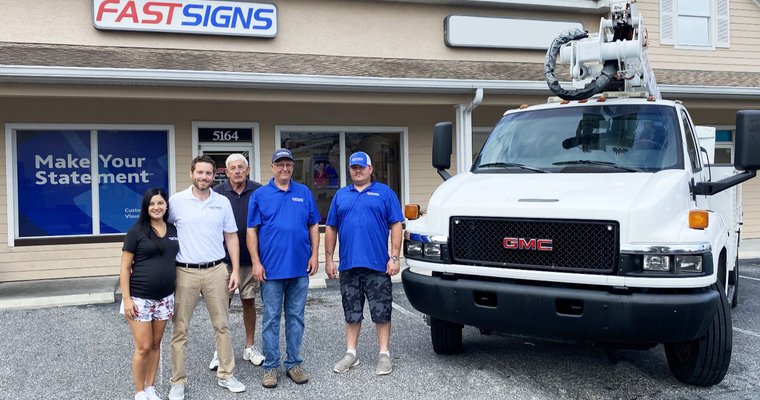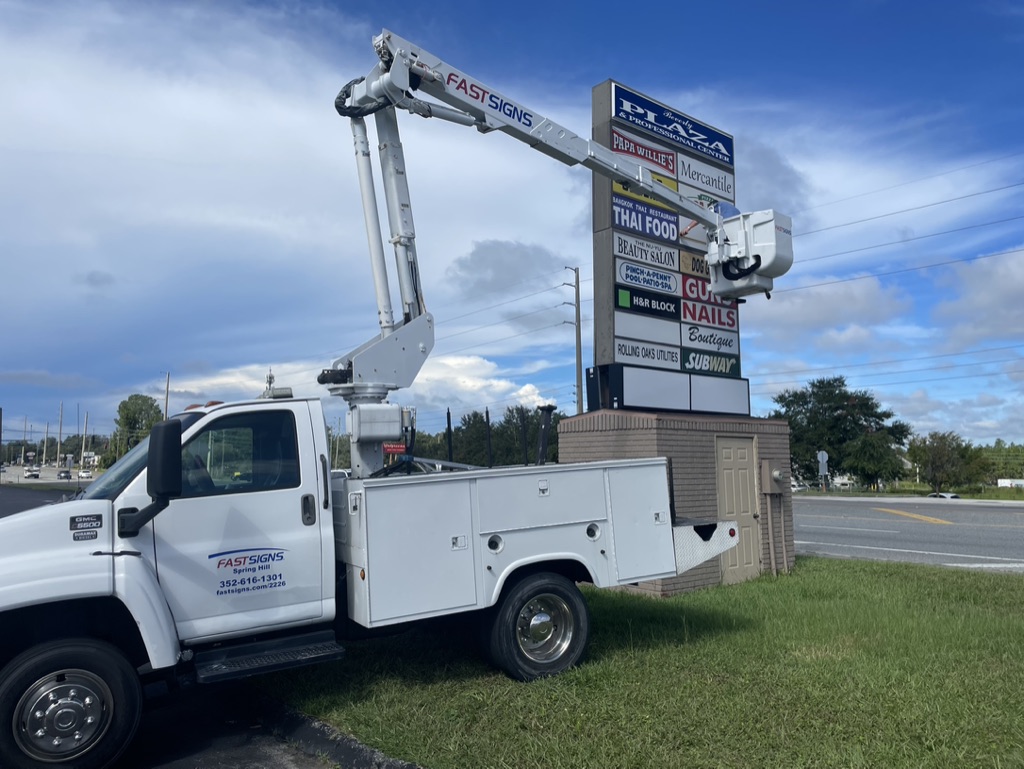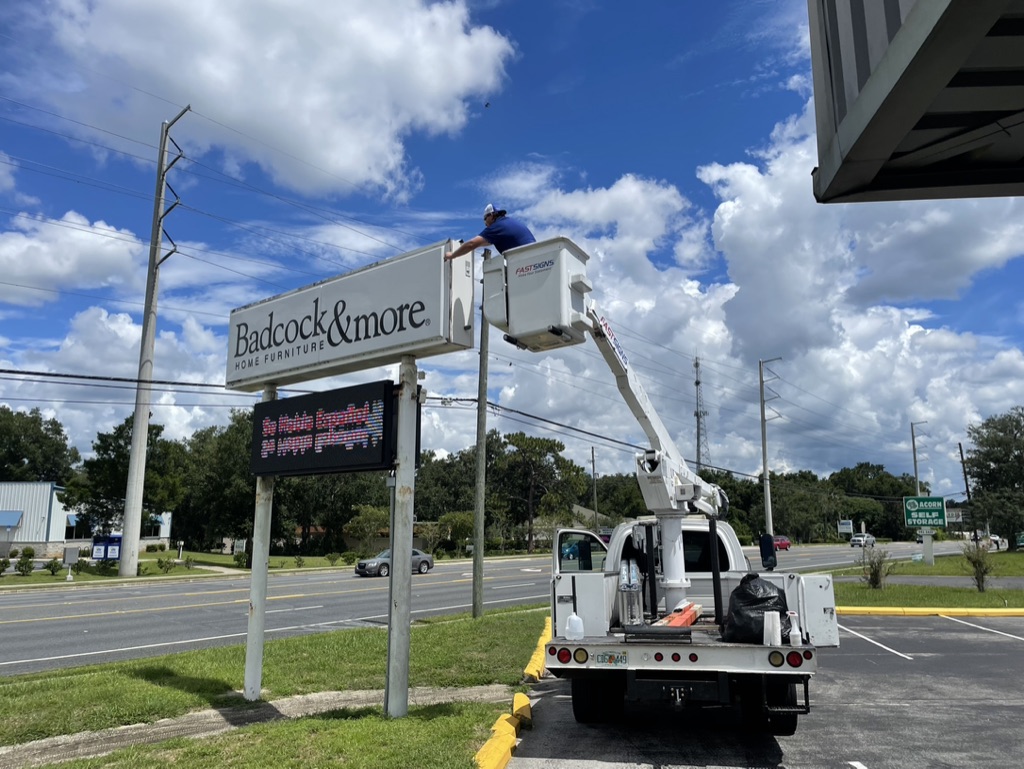
Ross Cartwright's path to signage owner/operator was unorthodox. He fell in love with graphic design going to Cincinnatti sports events as a child, and he avidly collected posters throughout childhood, eventually studying commercial photography and design at the college level before discovering how hard it was to break into that industry. He found work as a wedding photographer, but little joy: "I mean, it was repetitive!"
He rekindled his childhood passion in 2008 with a job at Holthaus Signs "I wanted to work in every department of the place because it was so fascinating to me," Cartwright said. "I fell in love again," he added. "It really opened my eyes to how big this signage world is, and how big it can be." It also introduced him to digital signage and design. Over the years, Cartwright got married and worked a variety of positions at FastSigns. He and his wife were considering moving to a warmer climate to start a family when, by coincidence, a FastSigns store went up for sale in Tampa. The young couple seized the opportunity, relocated, and Cartwright realized his dream of being a business owner.
"This was a good move," he said. "I'm home every day," he added. "Plus, I want to make something of my own."

1. Put in the hours
Still, the hours and workload can be punishing. "It's a lot more work. You have to be ready to work all hours, and come in on weekends and do late nights," Cartwright said. "We do everything from a small digital board for a church… (to) retail centers that have multiple units," he added. "We're still small-scale right now, two and a half employees plus myself," Cartwright said, and he wears a lot of hats and works at a fast pace. "But I like it. I'm not a guy that's happy just sitting around doing nothing."
Having support helps. If he feels overwhelmed by questions about something outside his experience, Cartwright knows he can call the corporate office for insight and resources. "So that's our big advantage," he added. "We don't have to figure it all out on our own."
Plus, there's a payoff. "You really get out of the business what you put into it," he said. "I mean, just working those extra couple hours every night and getting those extra few quotes out, which the next guy might not do, that just puts me one step ahead," he said, sharing a few of the principles that have brought him success in digital signage.
2. Start with research
"I would do research, really drive around," Cartwright said. "Who has digital signage already, and how can I match that with some of their competitors? You know, you go in and say, 'Hey, you know, your competitor down the road has got this cool, big digital sign. You know, I think we could do something similar to that,'" he added. "It becomes kind of a keeping up with the Joneses thing with different business types." Simply networking and sharing a quote goes a long way in finding a first job, and opportunities include small businesses and houses of worship.
3. Put people first
"It's a very relationship-driven business," Cartwright said. "Everybody that comes in the door, whether they're working with the front sales guy or not, I'll go out and introduce myself." It's vital to ignore the common temptation to hide in the office and rely on phone calls and emails. "You've got to meet people face to face, shake their hands, get to know that person a little bit, and you have to care," Cartwright said. "People want to do work with people that they like."
They also like feeling that they receive individual attention from someone who is local and invested, which is why they like seeing "owner" on Cartwright's business card. "That helps with sales a lot when I'm talking to customers," he explained. "You feel like you're going to get that special level of support and care and that your project is going to go right."
This is still rare in digital signage. "One of the things that I always saw is that people are really afraid of digital because they don't want to mess it up," Cartwright said, arguing that "once you do one or two, it just becomes easier, and easier, and easier, just like anything else."

4. Get organized, expect paperwork
"You have to block your schedule," Cartwright said. "I try to make sure at the end of the day, I can turn the lights off and make sure my whole checklist is done. Sometimes it's almost impossible to do, but I try to leave my computer at work every day, and get all my work done here, and then I don't have to be up all night trying to do something at home."
"Every sign that you put up has to have some sort of permit, even if it's a temporary sign," Cartwright said, and rules are often stricter for digital. Residential areas may restrict brightness, while highways may restrict motion or changing images for driver safety. Small towns may impose strict design rules to preserve the "local feel."
"Make sure you talk to the city first," Cartwright said.
5. Educate your customers
"A lot of times, customers are really shocked at the price of these digital signs," Cartwright said. "You really have to educate the customer. 'Hey, this is what you're getting. This is why it is so expensive. This is what you can expect out of this thing. You can run it 24 hours a day, seven days a week, and expect this same exact quality in 2, 3 or 4 years down the road,'" he added.
"Digital signage always attracts a lot more attention," Cartwright said. "And graphics become stale," he added, noting special opportunities like digital menu boards for fast food and QSR.
"The tools and the software components that come with the digital signs now have become so much more user friendly," Cartwright said. "A lot of times, a user can go right in there and change the message right then on their own; they don't need to hire anybody, or call anybody, and that's a big selling point too."
Even so, being flexible and understanding of customer needs is essential. "You can't go out and offer digital signage to everybody," he added. "You have to know your target audience."
6. Use 3 P's: patience, preparation, planning
"Anybody can do this. You just have to start at it, become an expert in different areas of this business, and you can go really anywhere," Cartwright said. "If you don't have any experience, maybe you work for a shop that does a lot of digital signage before you get started on your own, and that way you can learn about some of the vendors, you can learn about some of the processes, where the expenses are, a lot of the stuff with permitting," he added.
"I'd be completely screwed if I'd just jumped into this without a background in signage, which is what a lot of people do. So, it really helped me working in this industry before I got here on my own," Cartwright said. "If you've got assistance from a corporate office, like we do, or friends in the business, leverage them as much as you can to get going," he added.
"You really have to have a plan because there's so many working parts in this," he said. "If you don't plan it (a project), start to finish, before you even get started, you could find yourself in a big mess," he added. "If you set those realistic deadlines, under-promise and over-deliver… you're going to be in a much better place."
7. Lean into purpose, passion
Despite all the challenges, Cartwright keeps coming back to his passion. "There's really nothing like putting a big sign up with somebody's brand new logo, their brand new business or something that they've created, and seeing the smile on their face," he said.
Source: Digital Signage Today